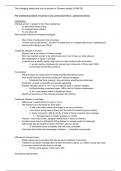The changing status and role of women in Chinese society (1949-76)
The traditional position of women in pre-communist China – patriarchal China
Introduction:
Chinese women = subject to the ‘three obediences’
- To their father when young
- To husband when married
- To son when old
Many women forced into arranged marriages
- Mao critical of subservient role of women:
“women hold up half the sky”, and the CP called them an “indispensable force in defeating the
enemy and building a new China”
Traditional attitudes to women:
- Women held a low status in Chinese society
- Rich men married women to be adornments, poor men to have an extra labourer
- Not independent or equal in marriage
- If married into a wealthy family, might have to share husband with concubines
(= women kept as mistresses by married men. Emperors of China kept 1000s
communists banned this practice.)
Foot binding:
- Practice begun by ruling class but widely emulated throughout China
- Girls would have their feet bound at age of 6, held by bandages
o Prevented feet from growing + bone structure would become deformed
Small feet: revered as beautiful and sexually appealing
- Practice officially banned in 1911, but it continued (esp in northern villages)
o Anti-foot-binding movement began 1880s, led by Christian missionaries
but it was deeply rooted in traditional culture
- Significant proportion of Han Chinese practised foot binding.
Traditional attitudes to marriage:
- Differences in wanting birth of a girl vs a boy
- Girl married out of the family by early teens
o lost to the family when could begin to be econ productive
o + the loss of giving away a dowry with the bride for benefit of groom’s family
(= dowry: payments / gifts by family of bride to family of groom when marriage
But dependant on wealth: jewelery vs clothes
- Women = economic burden, daughter denied food in favour of brothers
- Families would resort to infanticide (killing babies) to escape burden of raising girl
- Gifts would also be bought for family of bride by groom’s family
reinforced sense of property that had been purchased
- Confucian ethics abhorred remarriage of widows; .:. vulnerable economically
Attitudes of mothers-in-law:
- Brides subservient to husband and also all senior members of his family
- Traditional Confucian marriage didn’t provide emotional support, so mothers would stay close
to son who would look after them in old age
o So they were jealous of their son’s wife
Educational opportunities:
, The changing status and role of women in Chinese society (1949-76)
- No incentive to send girls to school because they would leave home .:. no economic benefit
for parents
- Rural survey in 1930s: only 1% of females over 7 could read, vs 30% for boys
Those who received schooling: 2% females, 45% males
1950 New Marriage Law
Early on could suggest that it was a genuine priority
Mao was committed to improving women’s rights
- For 1st time; received legal equality, could hold + inherit property, seek divorce
Woman equal in family: in decisions…
- Could also vote for 1st time.
- Paying dowries + child marriage = forbidden
- Concubines also ‘forbidden’
- Completely forbade foot binding
- Marriages could not be coerced; had to be free-willed (no arranged marriages)
Mao thought the NML was one of his great achievements
“this democratic marriage system has burst the feudal shackles that have bound human
beings, especially women, for thousands of years, and established a new pattern consistent
with human nature”
- Regime also advocated later marriage and childbirth; delaying this meant:
“the broad masses of the people have more time and energy to read and study, to
participate in political activity… it enables them to study Marxism, Leninism, and the writings
of Chairman Mao”
- NML and propaganda was effective
o In 1946, marriages where the bride was 16-17: 18%
by 1958-65: 2%
o In late 1940s, 30% of marriages arranged by parents
by 1966-76: 0.8%
Problems with the law:
- However legal changed = to transform lives of Chinese women
- Rocketing divorce rates, 1.4M petitions filed in 1953
- Many men lost what they perceived as a financial investment
esp problematic in poor peasant families
- Status of mothers-in-law = reduced
- Lots of violence; eg during divorce court proceedings
Attitudes of the cadres:
- Many refused to uphold the law in their local areas
Attitudes to gender equality in Muslim areas:
- bigamy outlawed
- Traditional Muslim communities resented the challenge to their long-held customs
o In non-Han Chinese areas like Xinjiang life for women remained unchanged
- Although fueled by propaganda, in 1953 there was so much opposition that the Party thought
it was necessary to launch a 2nd campaign to try promote it.





